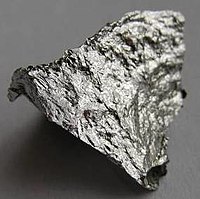
Photo from wikipedia
Abstract Corrosion studies in molten fluoride and chloride salts were surveyed, and key data were aggregated into a single dataset. Studies were graphed by salt purity, temperature, sample material, container… Click to show full abstract
Abstract Corrosion studies in molten fluoride and chloride salts were surveyed, and key data were aggregated into a single dataset. Studies were graphed by salt purity, temperature, sample material, container material, and experimental method (loop, capsule, crucible). To elucidate and quantify the factors that affect corrosion in molten salts, a data analysis using a newly-defined corrosion resistance score and a correlation analysis using techniques borrowed from machine learning were performed. It is shown that salt purity had the strongest correlation with corrosion rates in molten chlorides and fluorides. Data analysis across varied works was inconsistent due to the lack of standardization among molten salt corrosion studies.
Journal Title: Journal of Nuclear Materials
Year Published: 2018
Link to full text (if available)
Share on Social Media: Sign Up to like & get
recommendations!